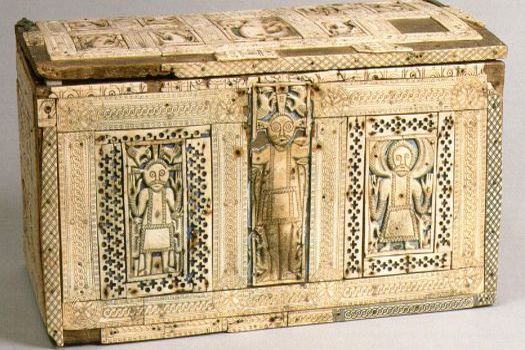Fremde Impulse Baudenkmale im Ruhrgebiet ist ein Projekt der beiden Landschaftsverbände Rheinland und Westfalen, LVR und LWL, in Zusammenarbeit mit der Kulturhauptstadt Europas RUHR.2010. weiterlesen >

Tragaltar für die Sachsenmission
Dieser Kasten gilt als Tragaltar („Portatel“) Liudgers und ist in das 8., spätestens beginnende 9. Jahrhundert zu datieren - mithin der älteste Tragaltar in Kastenform überhaupt. Der Reliquienkasten ist aus Holz und mit geschnitzten und durchbrochenen Elfenbeinplatten beschlagen, die nicht mehr in der ursprünglichen Ordnung gefügt sind. Auf der Vorderseite wird die mittlere mit „REX“ beschriebene Christusgestalt von zwei breiteren Figuren gerahmt.
© Schatzkammer St. Ludgerus Werden; Foto Jens Nober, Essen
Faith
The prevailing faith in a region was, time and again, superimposed by outside influences or foreign impetus such as conquests, missionary work, immigration, or migration of people. A belief initially regarded as “foreign” – just as Christianity was a new religion here in the 7th, 8th, and partway through the 9th century - could establish itself over the course of time. It could become a natural part of the power structure. The influences of newly arrived religions and denominations, and their impact over the course of the centuries can be read on historic buildings such as churches, monasteries, synagogues, places of pilgrimage, or prayer rooms. For example, early Christian influence in what is today’s Ruhr Region, changed during the Reformation through the emergence of varying evangelical persuasions. During the Industrial Age, starting in the 19th century, church life in part experienced a renewed Catholic influence due to high immigration. Ever since the 11th century people of Jewish faith had been settling in the Ruhr Region alongside Christian populations; and in Westphalia, since the 13th century. The Jewish faith, alongside the Christian faith, is therefore one of the religious orientations that appeared very early on in this region. Up until the middle of the 20th century it was mainly the Christian religions and Judaism which influenced society. After the Holocaust only very few, small Jewish communities attempted to make a fresh start here. With the immigration of Jews increasing since the 1980s, most notably from the former Soviet Union, these communities are again beginning to grow larger. Since the 1960s a great number of Muslim communities have come into existence, for whom in many places mosques have been built. Meantime, there is a large diversity of religious persuasions in the Ruhr Region. These include the varying Christian denominations, the Jewish communities, the religious Islamic communities, representatives of Far Eastern religions, and also new, rather esoterically oriented, religious groups.
Zu den Impulsen
hier geht es zu den einzelnen Impulstexten



